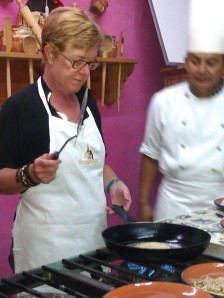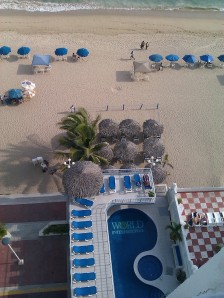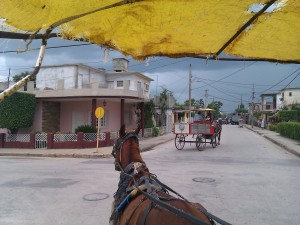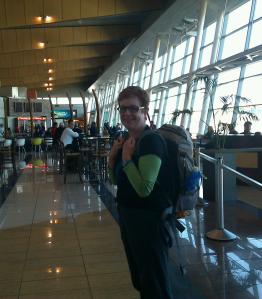
Grant, getting ready to run down the zip line above the rain forest at Lake Atitlan
We travelled to Guatemala from Mexico via shuttle bus through high mountain ranges. At the border a Guatemalan immigration officer asked me for US$20 “to stamp my passport”. However when I pressed my questioning and asked for a receipt the demand was suddenly withdrawn. I was pleased that I had been warned that this was not uncommon and to ask for a receipt.
Our first stop in Guatemala was Lake Atitlan, a large, highland lake nestled between mountains and three volcanos. Here the very steep hillsides are covered in patch-worked fields of corn, beans, coffee and avocados. Many families still rely on subsistence farming to feed their families however as child mortality has improved and the population grown, the availability of suitable agricultural land is desperately limited. As a result crops are now grown on land that is so steep that it must be extremely difficult to cultivate, never mind walk up and down.
Guatemala is very much like the southern state of Chiapis in Mexico which if fact was part of Guatemala until the late 1800s. The Mayan culture is still strong and people generally speak a Mayan language as their first language. There are eight towns/villages on the shores of Lake Atitlan and ferries are used for transport between the communities. It is a very popular tourist destination for young backpackers, (like ourselves, haha), and ex-pats who have made it their home. We got to chat with a couple of expats at the local sports bar who had chosen Lake Atitlan as their place to drop out. One guy, who was onto his third rum and it wasn’t even lunchtime, was living very comfortably on a Canadian disability pension. In fact, he told us that he was having trouble spending it all! Another told us about the panic attack he had two days before he was due to return home to the United States. He never made it there and is still stuck in Guatemala.
We had chosen the sports bar as our drinking hole because they had broadband TV and were showing the highlights of the opening Rugby World Cup game between the All Blacks and Tonga. (This was the only game we saw until we got to Santiago and the quarter finals.) Most people in Central America have no idea what rugby is – football is their game. However we met one guy knew enough to ask: “Is that the game where you tuck the ball under your arm and run?”
After a week at Lake Atitlan we discovered that we would have to delay our departure for a further day. National elections were being help on the day we hoped to travel and all public transport was ‘grounded’. This is only the fourth election since the end of 36 years of civil war and military dictatorship and this meant that people were taking it very seriously. While we did not witness any unrest, banning travel and the sale of alcohol was a security measure to ensure that people were less able to disrupt the election process.
Guatemala is a developing country with high levels of poverty and a very high crime rate – although we did not feel threatened at any point. Currently the biggest issues are created by the Mexican drug cartels that have moved into the area. It is not drug use which is the problem in this and other Central American countries but the business and transportation of drugs that creates the crime and other problems. The demand for the drugs comes out of the United States however it is the poorer countries of Mexico, Central and the north of South America where the social harm of the drug trade is having the biggest impact. This is a sad trend and one for which many of the locals cannot see a solution.
Our next stop in Guatemala was the old capital of Antigua,which was abandoned in 1772 after a major earthquake. The highlight of our week was a visit to the semi-restored ruins of the Santo Domingo monastery. The ruins, which cover a whole city block, had lain untouched since 1772 until 10 years ago. Underneath the rubble of a number of stone churches and other buildings we were able to view catacombs, crypts, mass burial sites and holy alters, one of which contained beautiful large carved statues that remained untouched by the falling masonry that destroyed the surrounding area. It was a spooky and fascinating experience. Once the archeologists were finished, the developers secured and preserved the sites and then built a 5-star hotel and several small museums that now house amazing collections. This includes religious icons made of solid silver, religious paintings, miniature religious icons used for home alters as well as pre-Colombian artifacts. An interesting addition to the pre-Colombian collection was that each beautiful item was paired to an equally amazing contemporary sculpture, which in themselves made for an high quality collection.

El Zonte Beach Restaurant
Next we headed further south to El Salvador we spent some time with a great bunch of surfies at El Zonte beach on the Pacific coast. Here we stayed at the Horizonte Surf Resort which is really a fun name for a simple motel-like complex on the shingle beach. There was three small restaurants on the beach were open-walled huts and sand floors where we ate as a group. Having spent a lot of time on our own, it was really nice to have the company of fellow travellers including a delightful two-year old and her surfie parents. Her father, Edgar, runs a surf school in Lima, Peru and her mother, Aimee, is a professor at Walden University which specialises in distance learning. This meant that Aimee could continue her work part-time while the family enjoyed a six month holiday chasing the surf. Other less social friends at the resort included a huge orange iguana, who liked to swim in the pool, and a large colourful guacamaya parrot.
Our final stop in Central America was Costa Rica where the wildlife and rainforests are the major attraction. We spent five days at eco-resort with the strange name of ‘Lands in Love’ (http://www.landsinlove.com/). The resort is owned by 18 Israeli animal-loving friends who moved to Costa Rica with their 30 dogs and 50 cats. (They had also chosen New Zealand as a possible venue but decided against us because one of their dogs is on our list of dogs banned from importation.) The resort is located in a magic place and our room overlooked the cloud forest, from which puffs of cloud rise as the day warms up. The second highlight was the food that they served in the vegetarian restaurant on site. This was the tastiest food of our whole trip and I picked up a lot of tips on vegetarian cooking from my conversations with the chef.
decided against us because one of their dogs is on our list of dogs banned from importation.) The resort is located in a magic place and our room overlooked the cloud forest, from which puffs of cloud rise as the day warms up. The second highlight was the food that they served in the vegetarian restaurant on site. This was the tastiest food of our whole trip and I picked up a lot of tips on vegetarian cooking from my conversations with the chef.
Next stop was the capital city of Equador, Quito which sits in a long, large valley in the Andes, 2,800 metres above sea level. (That’s the same altitude as the summit of Mount Ruapehu.) The landscape is of a grand scale so to get a better view we took a trip up the ‘teleferico’ (gondola) summits at nearly 5,000 metres. It was not a comfortable feeling riding up a single cable for 2 kilometres, particularly when the gondola stopped mid-journey. We survived but due to the rapid change in altitude I later succumbed to a ripper headache. This meant I had to take it easy for the next 24 hours until it finally subsided.
From Quito we returned to Santiago from where we had started our trip. Santiago which is a modern, well laid-out city with a European feel and this makes it a very pleasant city. To top it off we managed to obtain a one-bedroom apartment in a great part of town at a very good price. This was only the second time that we had enjoyed accommodation with our own kitchen and lounge which in contrast to 3-star hotels and hostels provides for a very relaxing time. As an added bonus we were able to watch the Rugby World Cup quarter-finals on cable channel, ESPN.

Watching the protesters and the police in Santiago.
Santiago has some great museums but it was a lively protest that provided one of the best entertainments with its array of armoured vehicles, tear gas and water cannons. Another entertainment that Grant had discovered on our first visit, and wanted to check out again, was what is colloquially labeled ‘Coffee on Legs’. Cafe Haiti has a unique selling point. Customers (mostly male) sit up at the counter and are served by gorgeous long-legged ladies in tight-fitting mini dresses and plunging neck-lines. Later Grant and I had some fun discussing if this type of cafe would take off in Wellington. 🙂
During our lasts few weeks of travel we were both looking forward to coming home but at the same time we were still very much enjoying our travels. We developed a comfortable, slow approach to travelling and really enjoyed the freedom of no itinerary. We discovered that we were very compatible travel companions, which was fortunate since we were together 24/7 for six months! We also found the whole journey was easier than we thought it would be. That’s because the facilities and infrastructure available to travellers is ubiquitous in the places we travelled, although the quality varied. Venezuela was by far the toughest, due to a lack of infrastructure, while Mexico and the Caribbean would have to rate as the cruisiest. Our travel was made easier as our Spanish language skills improved but we never made it to conversational level.
We flew out of Santiago late on Thursday 13th October and landed in Wellington on a cold, moist Saturday morning. However we were soon warmed up by the lovely welcome from our four children and a great breakfast at our favourite cafe, Elements in Lyall Bay. It is good to be home in wonderful New Zealand.





































